THERE IS A VOID on the map of Saint Charles County, Missouri. At first, it may seem strange that there is wilderness in the middle of one of the nation's fastest growing counties, especially since it is adjacent to the much-travelled Highway 40. But this is the old Weldon Spring Ordnance Works site, which has much 20th century wartime history.
According to the United States Department of Energy:
The U.S. Army acquired 17,232 acres in St. Charles County near Weldon Spring, Missouri, in 1941 as part of the World War II defense effort. From 1941 to 1945, the U.S. Army produced explosives at the Weldon Spring Ordnance Works. After the war, the government transferred ownership of some of the land to the State of Missouri, which used it to create the August A. Busch Memorial Conservation Area. Another portion went to the University of Missouri, which used it for agricultural purposes. Except for several small parcels transferred to St.Charles County and the Francis Howell School District, the Army retained the remainder for use as a training area.As a part of this eminent domain acquisition, the towns of Hamburg, Howell, and Toonerville were destroyed; however, you can still find their old cemeteries. This ultimately became part of the largest explosives plant in the United States.
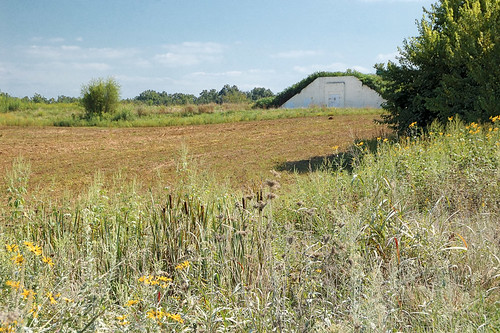
This is one of a hundred bunkers found in the August A. Busch Conservation Area. These were designed to safely store high explosives. Each bunker is at a distance from its neighbors, which would limit damage caused by inadvertent explosions.

A heavy steel door into one of the bunkers.
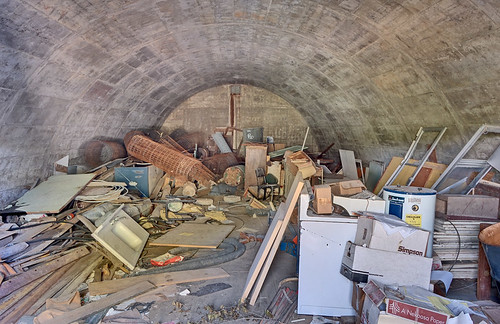
The interior of this bunker is filled with detritus. The interior of my own house isn't much better.
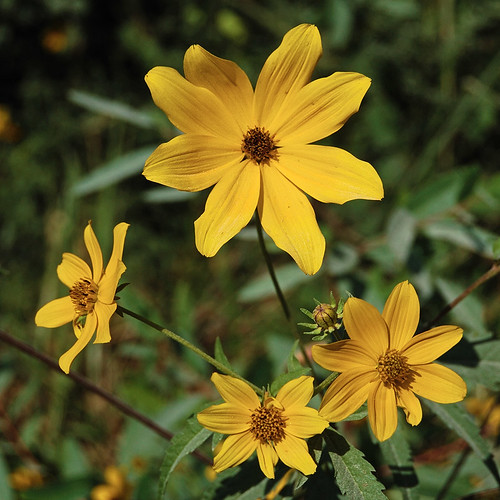
As a conservation area, this land is thick with wildlife, and is popular with hunters, hikers, fishermen, and nature photographers. And on this particular day, there were cross-country runners here; I felt quite sorry for them, since they were engulfed in white dust, kicked up from the dry gravel roads by each passing vehicle.
In the mid-1950s, this land was transfered to the U.S. Atomic Energy Administration, and uranium ore was processed here until 1966. This generated a large amount of radioactive waste. A subsequent clean-up effort collected the waste from various pits and put them under a large mound or cell, seen in the background of this photo:
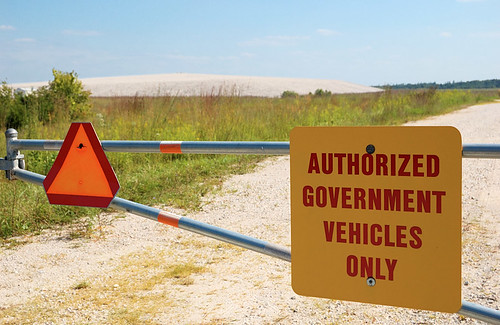
This mound is variously reported as being 47, 51, and 60 acres in size, and visitors can climb to the top of it. An aerial view of it, courtesy of Google Maps, gives a better idea of its scale:
View Larger Map
The cell is covered with limestone rubble, and was designed to last a thousand years.
There is still radiological and chemical contamination in the ground. The level of radiation in waters flowing from some local springs is several times higher than federal standards, but is declining. These levels are likely not particularly harmful; however, excavation and the use of shallow ground waters in this area is restricted.
The Weldon Spring Site is not actually in the town of Weldon Spring, but is near it; and that town was actually named after a spring once owned by someone named Weldon. And this spring still exists.
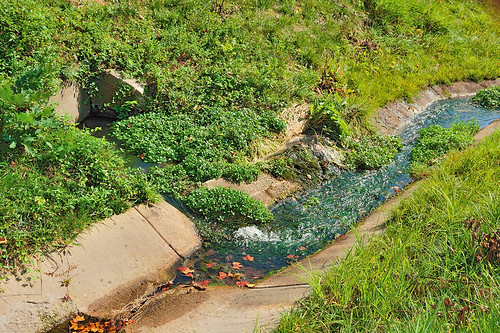
The spring is in a gully at the northeast corner of Highway 40 and Route 94, below an historic U.C.C. church and cemetery. The spring run, like those of most larger springs in the region, contains watercress. Due to local geology, this particular spring is not contaminated from the old Weldon Spring Ordnance Works.
Springs have fascinated me since I was a child, when I would visit Alley Spring and Big Spring in the Ozarks with my family. However, they are usually difficult to photograph well.
A wooden sign above the spring reads:

A heavy steel door into one of the bunkers.

The interior of this bunker is filled with detritus. The interior of my own house isn't much better.

As a conservation area, this land is thick with wildlife, and is popular with hunters, hikers, fishermen, and nature photographers. And on this particular day, there were cross-country runners here; I felt quite sorry for them, since they were engulfed in white dust, kicked up from the dry gravel roads by each passing vehicle.
In the mid-1950s, this land was transfered to the U.S. Atomic Energy Administration, and uranium ore was processed here until 1966. This generated a large amount of radioactive waste. A subsequent clean-up effort collected the waste from various pits and put them under a large mound or cell, seen in the background of this photo:

This mound is variously reported as being 47, 51, and 60 acres in size, and visitors can climb to the top of it. An aerial view of it, courtesy of Google Maps, gives a better idea of its scale:
View Larger Map
The cell is covered with limestone rubble, and was designed to last a thousand years.
There is still radiological and chemical contamination in the ground. The level of radiation in waters flowing from some local springs is several times higher than federal standards, but is declining. These levels are likely not particularly harmful; however, excavation and the use of shallow ground waters in this area is restricted.
The Weldon Spring Site is not actually in the town of Weldon Spring, but is near it; and that town was actually named after a spring once owned by someone named Weldon. And this spring still exists.

The spring is in a gully at the northeast corner of Highway 40 and Route 94, below an historic U.C.C. church and cemetery. The spring run, like those of most larger springs in the region, contains watercress. Due to local geology, this particular spring is not contaminated from the old Weldon Spring Ordnance Works.
Springs have fascinated me since I was a child, when I would visit Alley Spring and Big Spring in the Ozarks with my family. However, they are usually difficult to photograph well.
A wooden sign above the spring reads:
WELDON SPRINGSprings in Missouri typically have a near-constant water temperature close to the average air temperature, and there are likely no hot springs in the state. A National Weather Service forecast office, located only one mile to the south of here, reports an average annual air temperature of about 54 degrees Fahrenheit. The reported spring flow of 28,800 gallons per day, which is about a third of a gallon per second, was easily exceeded on this particular day.
Named for John
Weldon, who settled
this area in 1789.
This spring pumps
28,800 gal/day and
has an average temp.
of 53º F.

A hatch from LOST!
ReplyDeleteGreat page!
ReplyDeleteI've never found a picture of the actual spring before.
I enjoyed your writing here. I visited Big Spring frequently as a child as my grandmother lived in Van Buren, MO.
A side note: surely you mean "ORDNANCE" works and not "ORDINANCE".
You note that "As a part of this eminent domain acquisition, the towns of Hamburg, Howell, and Toonerville were destroyed; however, you can still find their old cemeteries."
ReplyDeleteHow would one find the old cemeteries?
There is a list of the old cemeteries, as well as the homesites of Hamburg, Howell, and Toonersville which were destroyed in 1940-41 here:
Deletehttp://thetntstory.blogspot.com/
Some of them are in fairly inaccessible areas and most require some hiking. The cemeteries are still being maintained to some degree by volunteers.
Steve
You can simply drive along hwy 94 when the leaves are gone and spot many of them from the road. Having hiked much of the area, and often leaving the trails, I've found them all over the August A Busch Conservation Area and the Weldon Springs Conservation area. Both of these areas are public recreation areas that you can explore all you want. Some are maintained, others are not, other than a fence added at some point.
DeleteI believe most of them are sealed aren’t they ?
DeleteGoogle found a few here.
ReplyDelete